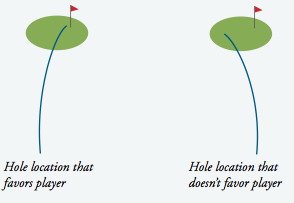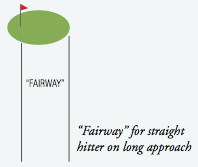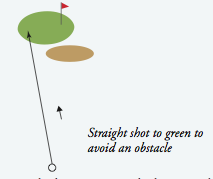Approach Shots
If there was one rule of thumb that needs to be followed when hitting an approach shot, it would be to avoid “short-siding” yourself at all costs. What is short-siding?
Short-siding is missing the green on the same side that the hole is, which means that the player will have little green to work with for a chip or a pitch. Short-siding is not always avoidable, but it should be minimized if at all possible.
Depending on the skill of the player, there comes a distance where it’s simply not advisable to aim for a flagstick that is on one side of the green. A skilled player may aim for the flagstick with, say, a 5-iron or shorter, while a lesser-skilled one might only do this with an 8-iron or shorter. A hole location in the middle of the green is the ultimate green-light situation for all players.
A flag that is situated either at the back or front of the green calls for shots to be played more towards the center of the green for lesser-skilled players. Skilled players can be more aggressive, but for them, too, there comes a point where center of the green is the smart play. Again, this point is dependent upon the length of the approach.
Right-to-left players can be aggressive towards a flagstick that is located on the left side of the green, and vice-versa for left-to-right players. In the case of a flagstick located on the same side of the green as where the ball would start (left side for a left-to-right player, right side for a right-to-left player), the golfer would best be served by aiming at the flagstick and then allowing the ball to curve away to the fat portion of the green. If the ball fails to curve, a great shot would result. If it curved normally, the player should still have a decent putt. If it curved more than normal, the player would have ample green to work with for a chip or a pitch.
Players who tend to hit fairly straight shots can be aggressive with the shorter irons, and many skilled players can apply this to middle irons, too. But, there comes a point where even the straight hitter needs to apply caution. A good visualization here for a flagstick either to the right or left is to create a small “fairway” between the flagstick and the far side of the green, aiming to put the approach into that “fairway.”
Many of us teach players who don’t hit the ball very far, such as seniors or ladies, and they may not be able get it to stop quickly on approaches. If there is an obstacle in their way, such as a bunker, it’s probably best that they play around it.
When an approach shot cannot reach the green, but a straight shot will leave an obstacle between the ball and the flagstick, playing around the obstacle is usually the smarter play.








